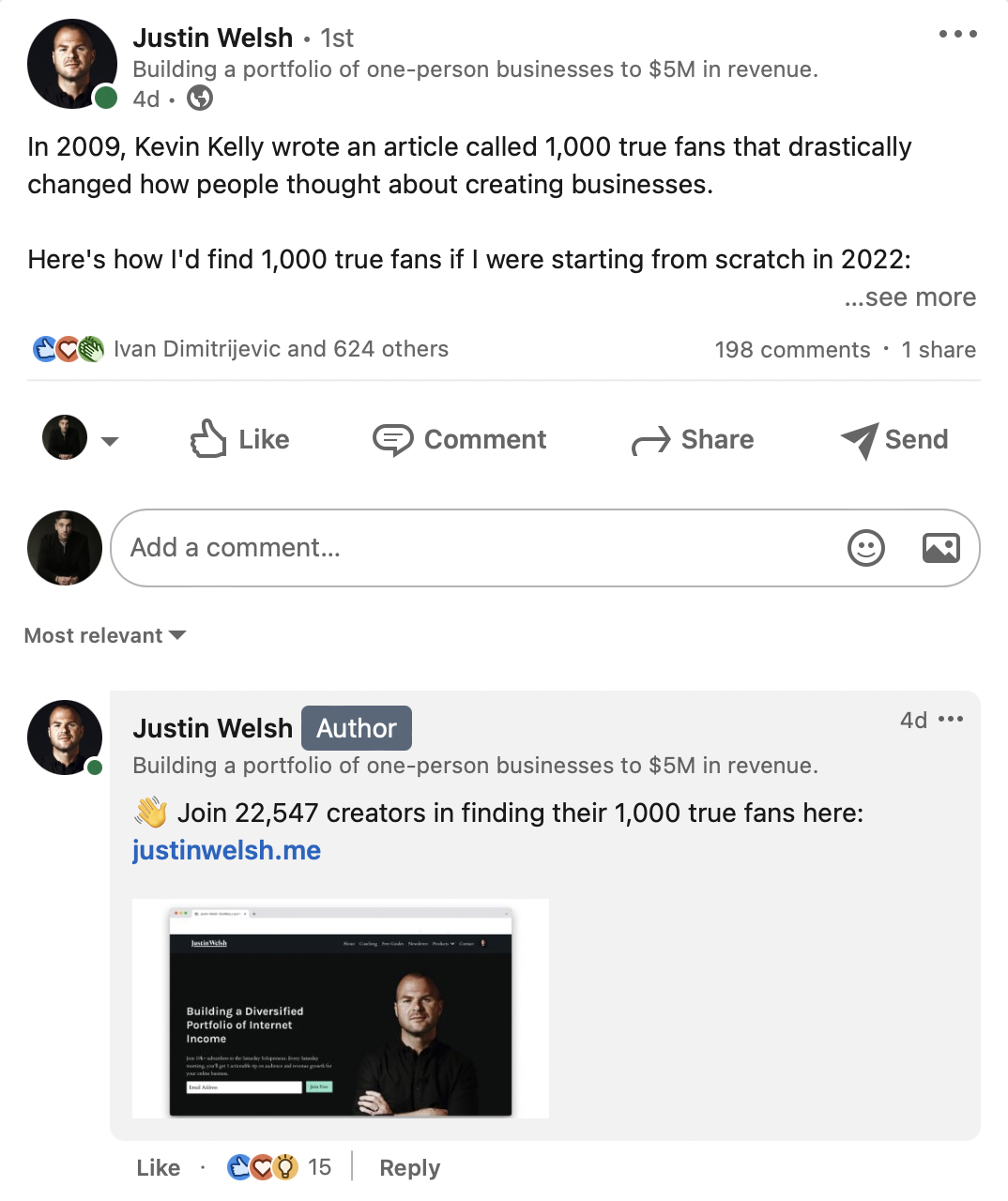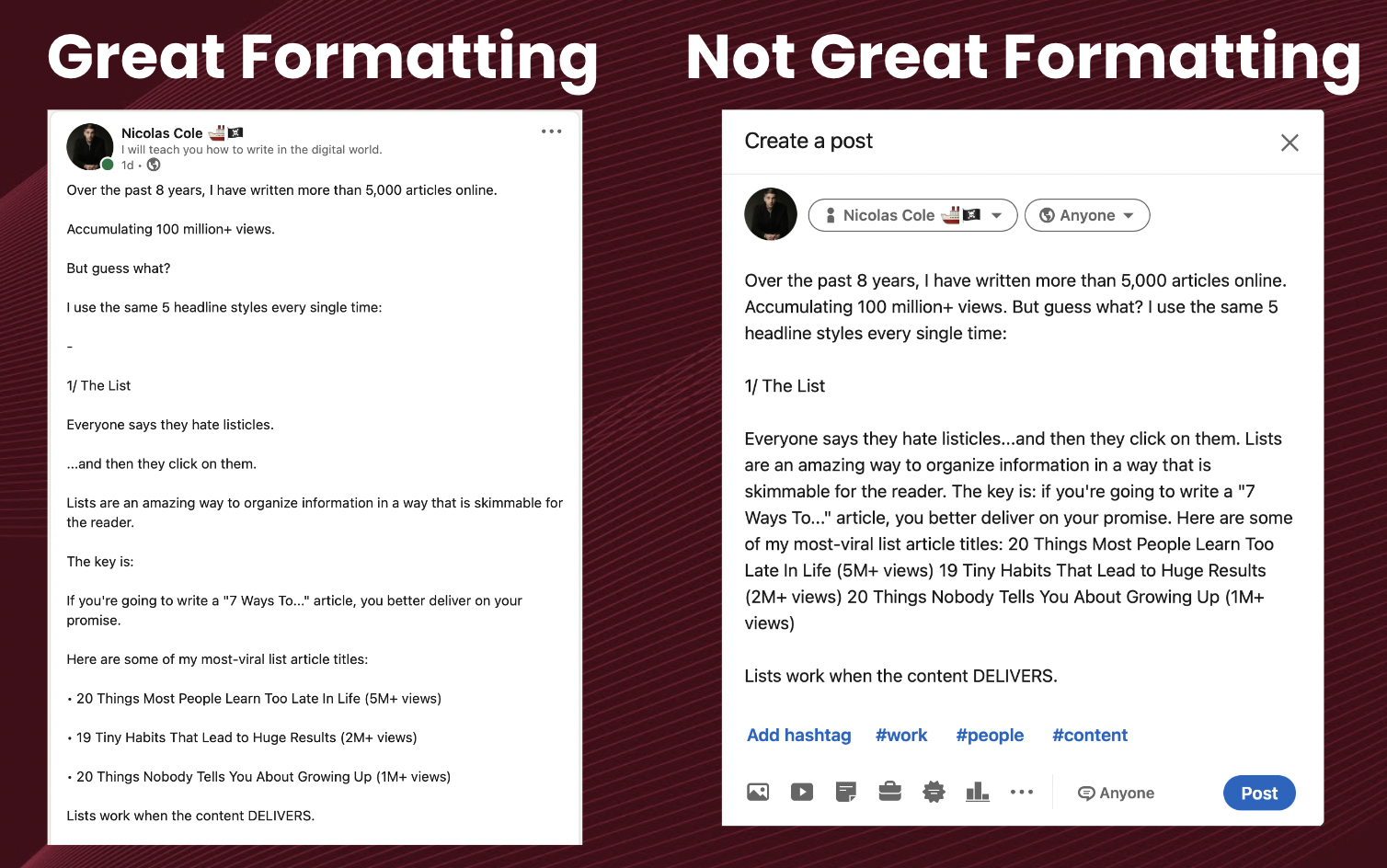Ahoy and happy Monday!
This week, we want to give you 12 strategies and examples for writing LinkedIn posts.
LinkedIn is the most explosive writing platform on the internet right now. With over 850 million members and a thirst for well-written valuable content, the LinkedIn algorithm offers insane reach (regardless of follower count). For example, Dickie’s very first post on the platform garnered 500k views and 4,500 likes.
Not a bad start.
If you write something helpful and engaging, it will find its way to hundreds of thousands of people.
Most content on LinkedIn is created by huge brands like The Home Depot “welcoming their summer interns” or individuals touting their credibility.
- Here’s my job title.
- Here’s our status symbol.
- Here’s my job experience
- Here’s why we’re important.
- Here’s my accomplishments.
It’s all about the brand or the person. Nothing wrong with that, it’s just not very helpful to the average reader.
People don’t follow you or engage with you because you are credible. People follow you because you are giving them something that improves their life in some way. Which means, the only way for LinkedIn to keep people on LinkedIn is for them to circulate the little amount of helpful content that *actually* finds its way on the platform.
For the last several months, we have been exploring the ins and outs of how LinkedIn works by writing and publishing there every day. And we want to share the strategies and examples we’ve seen work so you can use them in your own posts. (And as a reminder: if you want to level-up your Digital Writing game, crush Writer’s Block forever, and accelerate your own audience growth, we encourage you to use the proven templates on Typeshare.)
Let’s go!
Strategy #1: Copy/paste what already works on Twitter.
If it works well on Twitter, it will probably work well on LinkedIn.
Both are text-heavy writing platforms that reward clarity & conciseness. If you are just starting out on LinkedIn and have been writing on Twitter for a while, do what Nicolas Cole does: take your highest-performing content from Twitter and copy/paste it over to LinkedIn.
That's it

Strategy #2: Follow a familiar format.
There is a proven framework for crafting the perfect Twitter thread.
We follow these same principles on LinkedIn, with one exception: leave out The Recap.
Unlike Twitter, where The Recap can draw readers in with a single tweet, LinkedIn posts are short and packaged in a single reading experience that can be quickly scanned. This makes having a Recap in your post duplicative.
Here are the key elements you need in every Linkedin post:
- Lead-In: Grab the reader’s attention and tell them what they will get.
- Main Points: The “meat” of your post. This is what the reader wants.
- CTA: If you are going to direct the reader’s attention somewhere else at the end, link to it in the comments.

Strategy #3: Break up walls of text.
Posts you can skim are posts that win.
Follow these formatting guidelines:
- Use short punchy sentences.
- Space out your writing with carriage returns.
- Follow a catchy pattern: one sentence, 3 bullets, and repeat.
Readers are not spending hours on your post. So, keep their eyes moving down the page.
Notice the visual difference between these two posts.

Strategy #4: Get people to click the “See More” button.
The most important part of LinkedIn is the hook.
You get 5 lines to hook the reader and get them to click "see more."
- Tease what is inside the post without giving everything away.
- Let the reader know what value or entertainment they will get from reading.
- Summarize the entire journey and the transformation the reader can expect.
The reason is because the algorithm takes someone clicking "see more" as a signal to share it with more people. It’s not a trick. It’s a trade. It’s like watching a mystery movie. So, don’t give away the story unless the reader clicks.
Solopreneur, Justin Welsh, is a master at getting readers to click. In this post, you can’t help but click to find out how to build a massive LinkedIn audience. Who doesn’t want that?!

For help writing hooks, read our post on how to write viral hooks.
Strategy #5: Spark and encourage conversation.
LinkedIn rewards content that sparks engagement and conversation.
Just like a good hook engages the reader to “See More”, the more people that have conversations in the comments of your post, the more viral it goes.
So, at the end of every post, ask people to reply with a question or a big takeaway. Draw out opinions and insights from your readers by challenging them to critique your post. Ask them what you missed.
Then dive in the comments and respond!

Strategy #6: Share actionable content and personal stories.
The stuff that performs best on LinkedIn is:
- Actionable (because people are there to learn)
- Aspirational (personal stories on LinkedIn are rare, which makes them more engaging).
These are both part of our 4A framework that helps you come up with ideas to write about.
For a deep dive on the 4A framework, read this Twitter post.
For example, in this post Dickie, shares the story of building a personal habit. It works because it’s both actionable (something that can be done in 3 minutes) and aspirational (a habit to adopt that’s worked for someone else).

Strategy #7: Post the Call-To-Action in the comments.
Give your reader something to do after reading your post.
Guide the reader deeper into your content library.
But, don’t put a link to your opt-in, website, or landing page directly in the post itself. LinkedIn wants to keep readers on their platform and the algorithm, unfortunately, wags its pesky pointy finger in your face on this one. Instead, comment on your own post and include your call to action there.
Studies have shown that posting a link in the comments results in more reach and clicks.

Strategy #8: Turn a Twitter thread into a LinkedIn carousel.
LinkedIn posts can be text heavy, but images work too!
Use a tool like ThreadMagic to turn your Twitter thread into a carousel style post.
- Drop in a link to your thread into the tool.
- Take the pdf output and it to your post.
- Write a short lead-in.
- Boom! Done.
This is a good way to stand out and create a pattern interrupt from the normal text-heavy posts.

Strategy #9: Curate a popular stand-alone tweet.
Double down on (other people’s) data.
If you don’t have anything you want to share, but want to keep up the output, find a tweet that’s performed well on Twitter and share it as an image on LinkedIn.
- Look for a popular tweet using Twemex.
- Take a screenshot of the tweet or use poet.so.
- Upload the image to your post and write a short hook.
Sharing something that you already know that other people find interesting is a great strategy.

Strategy #10: Curate a list of anything.
Curate or list anything ranging from:
- People to follow
- Books to read
- Podcasts to listen to
- Templates to use
Consider your audience and what interests them, then make a list of what you find valuable. Chances are that other people in your network will find it valuable too. Notice this post is a combination of a list and a carousel. Mix and match! You are only limited by your creativity.

Strategy #11 Give away formulas and frameworks.
Every reader wants to learn a UNIQUE way to solve a SPECIFIC problem that is PROVEN to work.
So….
- What SPECIFIC problem does your framework solve? - Building a network
- In what new UNIQUE way? - Dream 100
- And what PROVES it’s guaranteed to work (credibility)? - Chet Holmes

Strategy #12: Provide “professional” entertainment.
LinkedIn is a professional AND social network.
It is the place on the internet to learn about the people behind top companies. The trick on this platform is to keep your posts industry and audience relevant, but also not boring.
Jennifer succeeds here by calling out pop-culture and relating it to her investor niche. Even if you are wearing a suit and trading stocks, you can engage your audience with entertaining pieces.

That does it for today’s Digital Writing Compass Deep Dive!
We hope you find these 12 strategies helpful on your journey to building a LinkedIn library of content.
Good luck and keep shipping!
Enjoyed this edition? Click here to share it on Twitter!
